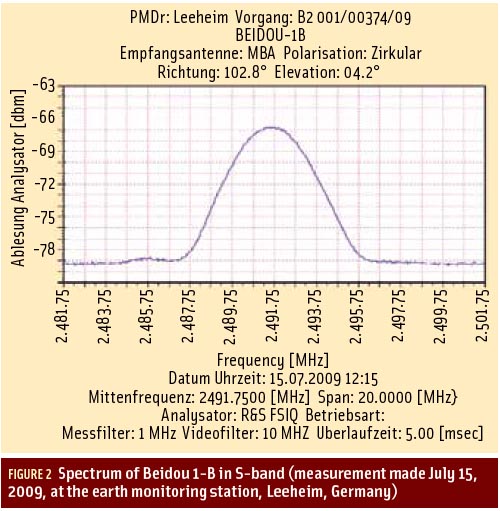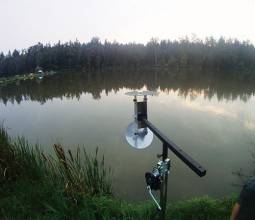GNSS utilization of the S-band portion of the radio spectrum provides some challenges to designers of both GNSS navigation signals as well as signals used by other services, in terms of interference avoidance and signal power.
An important existing user of S-band spectrum is the Globalstar communications satellite system. The voice and data services provided by Globalstar employ the 2483.5–2500 MHz band for its satellite downlink communications to user terminals. Additionally, these satellites use multi-beam antennas to enable frequency reuse.
GNSS utilization of the S-band portion of the radio spectrum provides some challenges to designers of both GNSS navigation signals as well as signals used by other services, in terms of interference avoidance and signal power.
An important existing user of S-band spectrum is the Globalstar communications satellite system. The voice and data services provided by Globalstar employ the 2483.5–2500 MHz band for its satellite downlink communications to user terminals. Additionally, these satellites use multi-beam antennas to enable frequency reuse.
Inside each beam, the 16.5 megahertz bandwidth is divided into 13 frequency division multiple access (FDMA) channels, each 1.23 megahertz wide, where fc=2491.77±k*1.23 MHz (k=0,1,…6)). Each channel supports up to 128 simultaneous users in a new code division multiple access (CDMA) scheme. (See the sidebar, “Globalstar Signal” for further discussion of the Globalstar design, by downloading the pdf of the complete article, above.)
This column will focus first on analyzing the potential interference that could occur between a GNSS system — for our purposes here, a hypothetical Galileo signal — and Globalstar. We will then discuss the potential for introducing a new-to-GNSS signal modulation — orthogonal frequency division multiplexing — for use in the S-band.
Assessing Potential Interference
Potential interference between Globalstar and hypothetical Galileo signals in S-band can be assessed through calculation of carrier-to-noise density ratio (C/N0) degradation that each system induces to the other. C/N0 degradation is calculated as the difference between the C/N0 of the interfered system without external interference and the C/N0 taking into account the interfering system.
. . .
Interference with Other Services
The 2483.5–2500 MHz band is used also for mobile services (MS) systems. Our calculations for radio determination satellite service (RDSS)/MS radio frequency compatibility indicate that only for a few GNSS signal options presented previously the intersystem interference criteria might be exceeded, and that even for those exceptional cases, interference to Globalstar caused by the Galileo signal is below that induced by Globalstar into GNSS.
Because no other internal compatibility problems between Globalstar and other mobile services have been reported, we conclude that the interference criterion considered is, in reality, far too conservative. Thus, the introduction of any of the presented modulations in S-band is not expected to cause harmful interference to any MS system.
The 2483.5–2500 MHz band is also planned for the deployment of future Worldwide Interoperability for Microwave Access (WiMAX) services. WiMAX service will have to be compatible with the signals already present in the band, and particularly with Globalstar.
Our computations show that the estimated interference on Globalstar due to WiMAX are similar to those due to Galileo. Accordingly, we believe that if WiMAX signals are robust enough to survive Globalstar interference, they should also be sufficiently robust against any hypothetical additional Galileo signal.
Fixed service allocations also exist in S-band, specifically from 2450 to 2690 MHz. These services consist of long range point-to-point links between two highly directive antennas. Again, our computations show that no additional limitation needs to be imposed on the RDSS PFD in order to prevent harmful interference with fixed services.
Future work will address the criteria needed to assess compatibility between several systems in a common band, including both the criteria of C/N0 degradation and effective C/N0.
Another Modulation Option: OFDM
Orthogonal frequency division multiplexing (OFDM) is a modulation technique used for numerous existing and forthcoming telecommunications and broadcasting standards, such as WiFi, WiMAX, digital video broadcasting (DVB-T, DVB-H, DVB-SH), and digital audio broadcasting (DAB).
The technique consists of transmitting data symbols over several orthogonal narrow-band subcarriers, for example, one symbol per subcarrier. In the latter case, each subcarrier is chosen such that it is narrow enough that the channel response can be considered as flat over the width of the subcarrier. Therefore, the impact of the propagation channel on the signal can be easily corrected using simple channel equalization techniques.
The narrowness and orthogonality of the subcarriers ensure excellent spectral efficiency with the signal PSD being almost rectangular. Even with a low symbol rate, a large number of subcarriers transmitted in parallel guarantees a high global data rate.
. . .
OFDM Potential for Navigation
In order to investigate the potential of OFDM signals for navigation and, in particular, their ranging capability, this section presents a case study of the existing digital video broadcasting — satellite to handheld (DVB-SH) standard.
The European Telecommunications Standards Institute (ETSI) developed the DVB-SH standard for the transmission of mobile TV signals in S-band. The combination of ground stations with geostationary satellites in a synchronous SFN is planned, while current research activities are assessing the use of this standard to provide signals of opportunity for positioning.
. . .
OFDM Summary
OFDM signals are spectrally efficient and can provide reasonable performance in terms of ranging capability. If a totally new signal is designed for combining telecommunication and navigation services with a high constraint in terms of out-of-band emissions, then the OFDM modulation could be an interesting candidate.
OFDM could allow for an efficient use available bandwidth, supporting communication services as well as GNSS and thus enabling the addition of other capabilities — location based services, integrity, data aiding, messages, other data channels, and so forth — and/or navigation data including ephemerides, almanacs, and other reference data.
We recommend further study of the usage of OFDM modulation for navigation signals. Relevant subjects that remain to be addressed include:
- The issue of the emitter’s discrimination in an SFN. In order to address this problem, the MC-CDMA modulation discussed in the article by S. Hara and R. Prasad could be investigated.
- The sharing of bandwidth between the telecommunication data and the pilot data used for navigation can be adapted to a desired configuration, depending on the balance between the two services. For example, more pilots would improve tracking at the expense of telecom capacity.
- OFDM is known to have a high peak-to-average power ratio, which creates heavy non-linear distortion introduced by the satellite on-board high power amplifier. This issue can be addressed by using coding or pre-distortion techniques in order to reduce the PAPR.
Considering moreover that the bands above 2.5 GHz are mobile bands and likely to be used for either WiMAX or 3G LTE (both of which use OFDM techniques), the use of OFDM for an S-band navigation signal baseline becomes even more interesting.
Conclusions
The potential benefits of a future Galileo S-band in terms of performance and frequency compatibility are many. Those benefits include the capability of multiple new RNSS signals and services sharing the band, as well as combining mobile satellite communications solutions with typical navigation approaches.
In this two-part column, we have assessed various exemplary signals to prove the concept, and we recommend further research.
Performance improvement alone does not drive the addition of new frequencies for GNSS, but rather provides an opportunity to serve user groups currently lacking the performance they need with the current RNSS signals provided by L-band.
Several frequency band options are being studied in the framework of the evolution of Galileo. Assuming a new service would be identified for a future GNSS system, no matter what the final selected signal would be, backward compatibility with legacy modulations is essential for legacy users.
Radio frequency compatibility between S-band RDSS systems, Globalstar, and other terrestrial mobile or fixed services seems to be possible. In the next 5 to 10 years, if the L1 band continues to be occupied by more and more RNSS systems, worst-case C/N0 degradation on the order of 2.5 decibels could occur, without even taking into consideration the effect of non-RNSS interference in L1.
In such a scenario, the potential addition of GNSS signals in S-band looks promising. However, further detailed studied is needed, addressing all necessary signal design criteria and design trades among the various new frequency options. These include GNSS S-band modulation methods such as BPSK, BOC, MBOC, OFDM, and other solutions. In this context, to support potential future signals in S-band, a Galileo 2 filing including the 2.5 GHz band is available for review on the ITU website.
For the complete story, including figures, graphs, and images, please download the PDF of the article, above.
Disclaimer
The authors would like to make it clear that Europe has not yet decided on use of an additional RF band — e.g., S-band — for the second generation of Galileo, other than to ensure that any future frequency plan is backward-compatible with the system’s current navigation signals. Accordingly, this column should be considered as a scientific exercise that only emphasizes the great interest in considering use of this band for GNSS systems.
Additional Resources
[1] International Telecommunications Union Recommendation, ITU-R M.1831, “A coordination methodology for RNSS inter-system interference estimation,” 2007
[2] European Telecommunications Standard Institute ETSI EN 302 583, “Digital Video Broadcasting (DVB); Framing Structure, channel coding and modulation for Satellite Services to Handheld devices (SH) below 3 GHz,” 2008
[3] Thevenon P., (2009a) and O. Julien, C. Macabiau, D. Serant, S. Corazza, M. Bousquet, . Pseudo-Range Measurements Using OFDM Channel Estimation, Proceedings of the ION GNSS 2009, pp. 481-493, 2009
[4] Thevenon, P., (2009b) and O. Julien, D. Serant, L. Ries, S. Corazza, et al., “Positioning principles with a mobile TV system using DVB-SH signals and a Single Frequency Network,” 16th Conference on Digital Signal Processing, 2009
[5] Serant, D., and O. Julien, C. Macabiau, P. Thevenon, M. Dervin, S. Corazza, L. Ries, and M. L. Boucheret, “Development and Validation of an OFDM/DVB-T Sensor for Positioning,” IEEE/ION PLANS, 2010
[6] Hara, S., and R. Prasad, “Overview of Multicarrier CDMA,” Communications Magazine, IEEE, vol.35, no.12, pp.126-133, December 1997
[7] Cioni, S., and G. E. Corazza, M. Neri, and A. Vanelli-Coralli, “On the use of OFDM Radio Interface for Satellite Digital Multimedia Broadcasting Systems,” International Journal of Satellite Communications and Networking, vol. 24, no. 2, pp. 153-167
[8] Bingham, J.A.C., “Multicarrier modulation for data transmission: An idea whose time has come,” IEEE Communications, vol. 28, 1990
[9] Godet, J. “GPS/GALILEO Radio Frequency Compatibility Analysis,” ION GPS, 2000
[10] de Gaudenzi, R., “Payload Non-linearity Impact on the Globalstar Forward Link Multiplex. Part I. Physical Layer Analysis,” IEEE Transactions on Vehicular Technology, vol. 48, no. 3, May 1999
[11] L. Schiff, L., and A. Chockalingam, “Design and System Operations of Globalstar versus IS-95 CDMA, Similarities and Differences,” Wireless Network, 6:47-57, 2000





